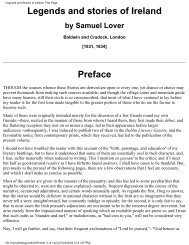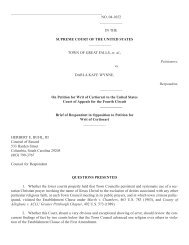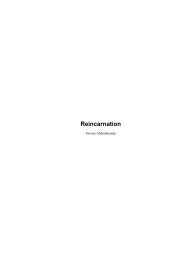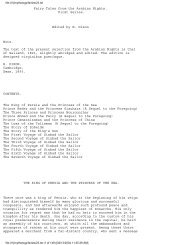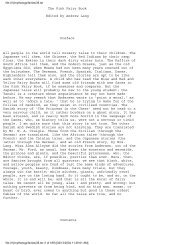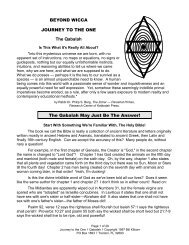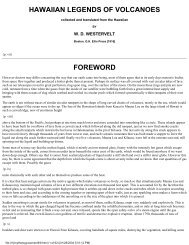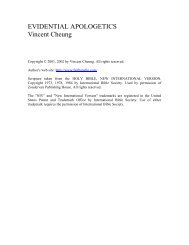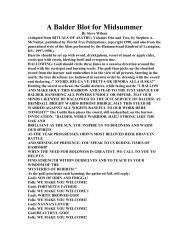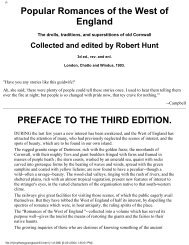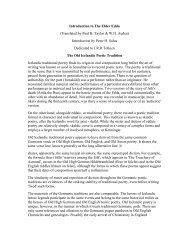Irish Druids And Old Irish Religions PREFACE CONTENTS
Irish Druids And Old Irish Religions PREFACE CONTENTS
Irish Druids And Old Irish Religions PREFACE CONTENTS
You also want an ePaper? Increase the reach of your titles
YUMPU automatically turns print PDFs into web optimized ePapers that Google loves.
to keep her from the sight of a man. All went well till McKineely consulted the Banshee of the mountain. Telling him to dress in women's<br />
garments, she ferried him to the island, asking shelter for a noble lady chased by an enemy. Landing the young man, she threw the dozen<br />
guardians into a Druidic sleep, and left the couple together awhile, afterwards rowing the man ashore. Serious results ensued.<br />
Fairies are more pronounced in <strong>Irish</strong> than in English traditions. They are fairly represented in the west of Scotland, in Wales, Lancashire,<br />
and Cornwall, parts frequented by <strong>Irish</strong> friends and foes.<br />
They are Sides, Sighe, Sith, Duine Matha, or Good People. Fear-sig of the supernatural world are <strong>Irish</strong> forms of the Welsh Tylwyth teg,<br />
the fair family; Swedish, Nissen;<br />
p. 92<br />
Danish, Damhest; Polish, Rotri; the Russian, Domavoi; English, Puck, Elf, Fay, or Robin Goodfellow; Cornish Pixie; Burmese, Nats;<br />
Breton, Korigan, or Koril; Scotch Brownie; Norwegian, Trolls, or Nyss; Oriental, Jin; Jewish, Schedim; Italian, Fata; Greek, Parcæ, or<br />
Eumenides.<br />
"That which is neither ill nor well,<br />
That which belongs not to heaven or hell."<br />
Because many are represented as little men, writers have fancied the idea was but a tradition of pre-existing races, small in stature, who<br />
were improved off by visitors or marauders of larger growth. Dwarfs or Duzes are thought in Brittany to haunt the dolmens, or ancient<br />
graves, though in some manner they are known as the ghosts of <strong>Druids</strong>. Certainly Africa bears evidence of a wide-spread pigmy race.<br />
There are Dokos of South Abyssina, Obongo of West Africa, Akka of Central Africa, Batua living in trees like monkeys, and others in<br />
Congo, &c.<br />
The Fairies are associated with mankind at present, though they may carry off their children, replacing them by changelings. The<br />
mannikins may be white, brown, grey, or yellow. Some are small enough to sit in ears of corn, while others fly about on magic horses. It is<br />
sad to know that these little people indulge in faction fights, and pinch those who dance with them. Giants figure less often. The Book of<br />
Leinster tells of giant Luter, with fourteen heads, wooing Gobal, whose charms extended over fifty cubits.<br />
Occasionally these little people are not content with stealing babies, but would run off with men; as Nea, of the golden hair, did the <strong>Irish</strong><br />
Fenian warrior. The busy Maakiset, who worked underground, were more worthy of offerings than the Kapeet, who caused eclipses by<br />
catching hold of the moon. It is discreet always to speak well of<br />
p. 93<br />
fairies, as they listen without being seen. Their females look after men, as their males look after women.<br />
They have kings and queens. Oberon or Elberich was a king, and Titania a queen. The <strong>Irish</strong> say that Don, the Milesian leader, drowned in<br />
a storm raised by the Tuaths, became a King of the Fays. Inis Mananain, now Isle of Man, was so called from Mananan, an ancient chief<br />
transformed to a royal Sidhe. Mab, daughter of King Eochaidh Faidhleach, became Queen of the Fairies, being more than immortalized in<br />
Spenser's Fairy Queen. Another King of the Fairies was the Tuath Fionnbharr. The Welsh Fairy King was Gwyh ab Nudd.<br />
As these spirits of air, earth, and water are numerous, it is a comfort to learn from the Talmud that, while the bad ones are exactly<br />
7,405,926, the good ones number, in the rougher estimate, I,064,340,000,000,000.<br />
.Black fairies are not conspicuous, unless in the mines. The Maories of New Zealand assure us that their merry little fays are not of their<br />
dark colour, but fair like Englishmen. They love the hills of Waikato. A chief, frightened of them, took off his ornaments, and gave them<br />
away. As soon as they finished their song, as he told the tale, they took the shadows of the Maori's earrings, and handed them about from<br />
one to the other.<br />
As all know, the Fairies, or Peris, are suffering from some misconduct in happier climes. Christian tradition holds to their final<br />
redemption.<br />
<strong>Irish</strong> fairies are thus mourned for by D. F. McCarthy:--<br />
p. 94<br />
"Ah! the pleasant time hath vanished ere our wretched doubtings banished<br />
All the graceful spirit people, children of the earth and sea--<br />
Whom in days now dim and olden, when the world was fresh and golden,<br />
Every mortal could behold in haunted rath and tower and tree--<br />
They have vanished, they are banished. Ah I how sad the loss for thee."<br />
Some were not so pleasant:--<br />
"While the Phooka horse holds his frantic course<br />
O'er wood and mountain fall,<br />
<strong>And</strong> the Banshee's croon, a rhythmic rime<br />
From the crumbling, ivied wall."<br />
file:///I|/mythology/witchcraft/8/8.html (34 of 114) [02/05/2004 8:38:14 AM]



